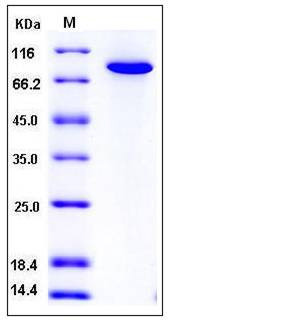Human TGM2 / Transglutaminase 2 Protein (His Tag)
G-ALPHA-h,GNAH,HEL-S-45,TG2,TGC
- 100ug (NPP4306) Please inquiry
| Catalog Number | P11095-H07B |
|---|---|
| Organism Species | Human |
| Host | Baculovirus-Insect Cells |
| Synonyms | G-ALPHA-h,GNAH,HEL-S-45,TG2,TGC |
| Molecular Weight | The recombinant human TGM2 consists of 705 amino acids and has a predicted molecular mass of 79.6 kDa. It migrates as an approximately 80 kDa band in SDS-PAGE under reducing conditions as estimated. |
| predicted N | His |
| SDS-PAGE |  |
| Purity | > 97 % as determined by SDS-PAGE |
| Protein Construction | A DNA sequence encoding the human TGM2 (NP_004604.2) (Met 1-Ala 687) was expressed, with a polyhistidine tag at the N-terminus. |
| Bio-activity | |
| Research Area | Neuroscience |Cell Adhesion Proteins |Receptors in Cell Adhesion Proteins |Associated Proteins |
| Formulation | Lyophilized from sterile 50mM Tris, 100mM NaCl, 2mM DTT, 10% glycerol, pH 8.0 1. Normally 5 % - 8 % trehalose and mannitol are added as protectants before lyophilization. Specific concentrations are included in the hardcopy of COA. |
| Background | Protein-glutamine gamma-glutamyltransferase 2, also known as Tissue transglutaminase, Transglutaminase C, Transglutaminase-2, and TGM2, is a member of the transglutaminase superfamily. TGM2 plays a role in cell growth and survival through the anti-apoptosis signaling pathway. It is a calcium-dependent acyltransferase which also undergoes a GTP-binding/GTPase cycle even though it lacks any obvious sequence similarity with canonical GTP-binding (G) proteins. TGM2 is a multi-functional protein which catalyzes transamidation reactions or acts as a G-protein in intracellular signalling. As an enzyme which is responsible for the majority of transglutaminase (TG) activity in the brain, TGM2 is likely to play a modulatory role in nervous system development and has regulatory effect on neuronal cell death as well. Most importantly, numerous studies have presented data demonstrating that dysregulation of TGM2 may contribute to the pathogenesis of many neurodegenerative disorders, including Huntington's disease, Alzheimer's disease, Parkinson's disease and amyotrophic lateral sclerosis as well as nervous system injuries. |
| Reference |
